[This note covers all of the "Thomas A. Edison-Henry Ford Office Correspondence" folders in Series I.]
These documents, which cover the years 1913-1931, consist primarily of letters exchanged between secretaries and company officials in the offices of Thomas Edison and Henry Ford. The principal correspondents are William G. Bee, vice-president of the Edison Storage Battery Co.; Ernest G. Liebold, Ford's personal secretary and managing editor of The Dearborn Independent; and William H. Meadowcroft, Edison's personal secretary. Other correspondents include Edison, his wife Mina Miller Edison; his sons Charles and Theodore Edison; and Edison company officials Robert A. Bachman, Nelson C. Durand, Miller Reese Hutchison, Walter S. Mallory, Stephen B. Mambert, and John V. Miller.
Included are letters relating to Edison's attempts to develop a battery and starting system for the Model T; the purchase of Edison cement for the construction of Ford's factory buildings; the use of Edison dictating machines by the Ford Motor Co.; military research during World War I; and Edison's experiments in producing rubber from plants. Also included are letters exchanged between Mambert, financial executive of Thomas A. Edison, Inc., and Liebold regarding money lent by Ford to Edison and to the overall financial health of the Edison companies. Consolidated balance sheets and other financial data appear as attachments to these letters. (Similar balance sheets can be found in Series III: Documents.)
In addition, there are letters concerning Henry Ford's Peace Ship mission to Europe in December 1915; his libel suit against the Chicago Tribune; his antisemitic "International Jew" series in The Dearborn Independent; recordings of the Ford orchestra made by the Edison Phonograph Division; the construction of the Henry Ford Museum in Dearborn, Michigan, and the transfer of the Edison Pioneers Historical Collection to the museum; the establishment of the Edison Institute of Technology in Dearborn; and the celebration of Light's Golden Jubilee in October 1929. There are also references to Edison's summer camping trips with Ford, naturalist John Burroughs, and rubber manufacturer Harvey S. Firestone. Other items of a personal nature include correspondence about Edison's health, his opinions on cigarette smoking and economics, birthday celebrations, and family vacations at the Edison winter home in Fort Myers, Florida. The letters from 1931 deal primarily with the declining health of Edison and Meadowcroft.
All substantive letters pertaining to Edison's business operations and personal affairs have been selected. The following categories of documents have not been selected: routine letters of transmittal and acknowledgment; non-substantive correspondence concerning the ordering, shipping, and billing of materials; letters about routine financial transactions; most letters and telegrams involving travel arrangements for persons other than Ford and Edison; and documents that merely duplicate the information in selected items.
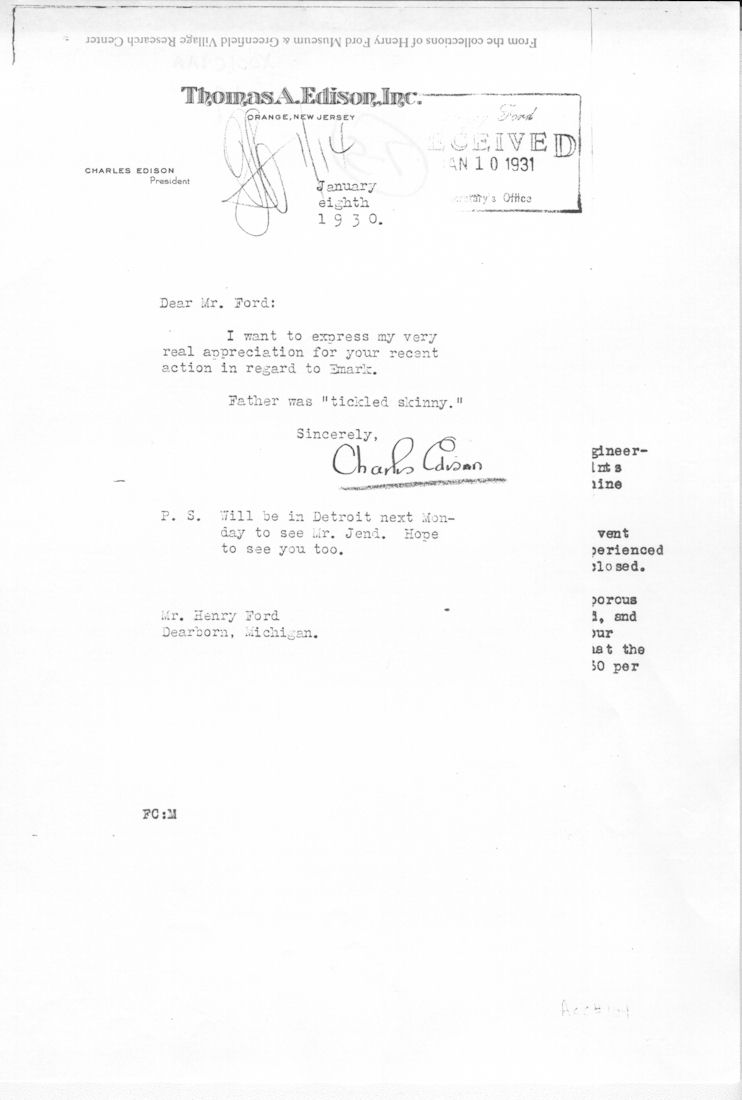 [X001C9AA], Letter from Charles Edison to Henry Ford, January 8th, 1931 1931-01-08
[X001C9AA], Letter from Charles Edison to Henry Ford, January 8th, 1931 1931-01-08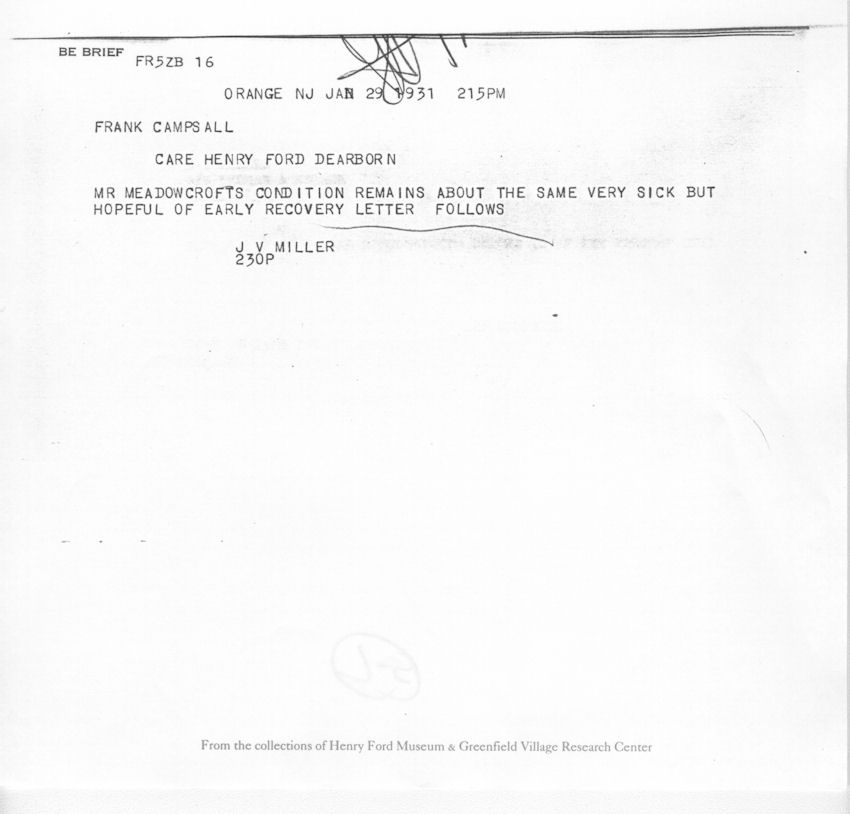 [X001C9AB], Telegram from John Vincent Miller to Frank Campsall, January 29th, 1931 1931-01-29
[X001C9AB], Telegram from John Vincent Miller to Frank Campsall, January 29th, 1931 1931-01-29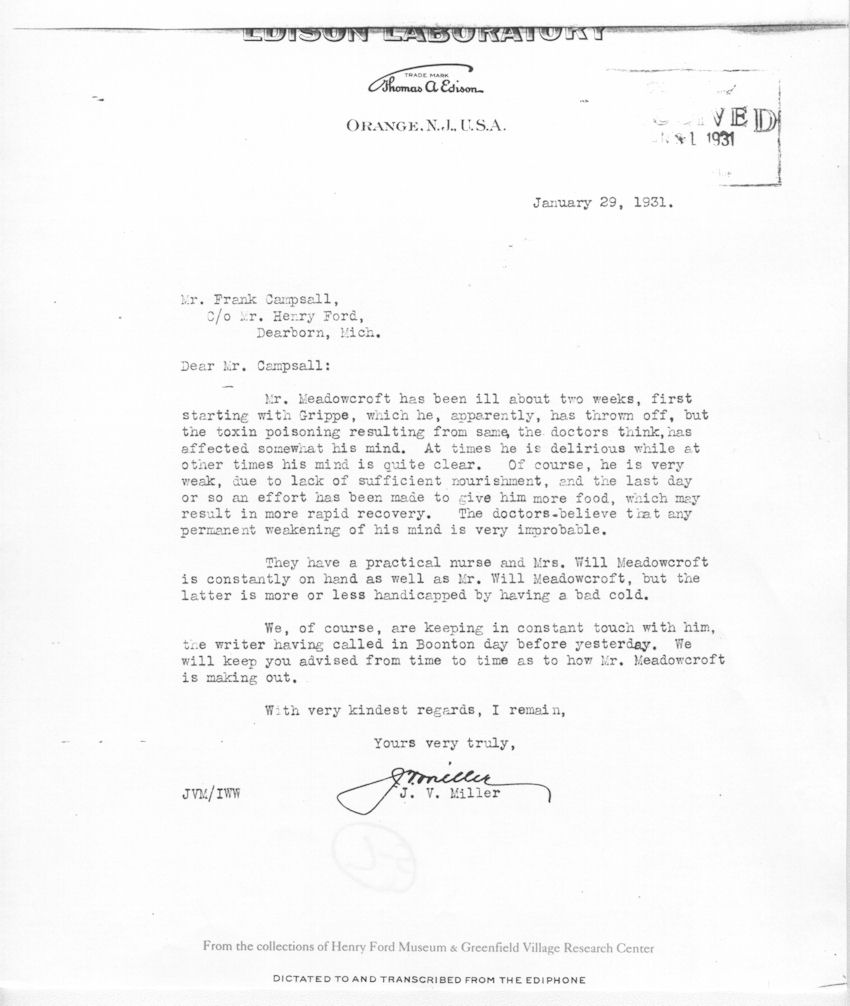 [X001C9AC], Letter from John Vincent Miller to Frank Campsall, January 29th, 1931 1931-01-29
[X001C9AC], Letter from John Vincent Miller to Frank Campsall, January 29th, 1931 1931-01-29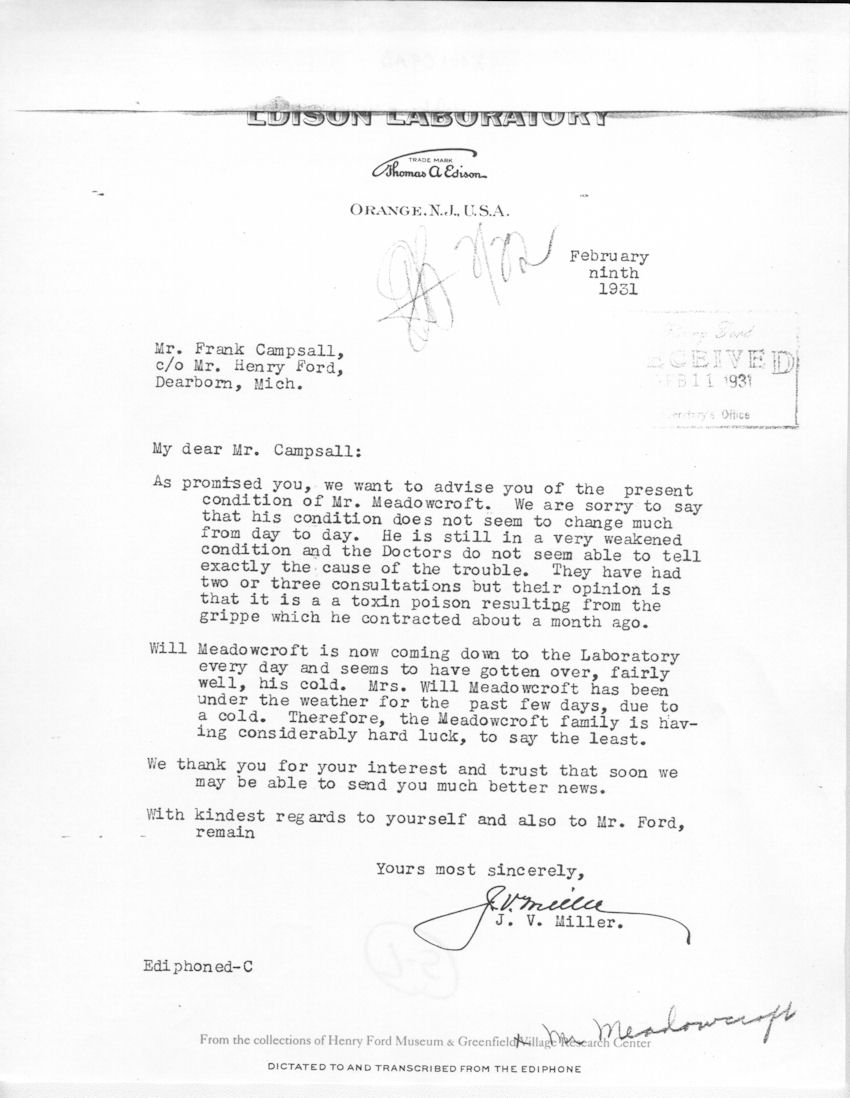 [X001C9AD], Letter from John Vincent Miller to Frank Campsall, February 9th, 1931 1931-02-09
[X001C9AD], Letter from John Vincent Miller to Frank Campsall, February 9th, 1931 1931-02-09 [X001C9AE], Telegram from Henry Ford to Thomas Alva Edison, February 11th, 1931 1931-02-11
[X001C9AE], Telegram from Henry Ford to Thomas Alva Edison, February 11th, 1931 1931-02-11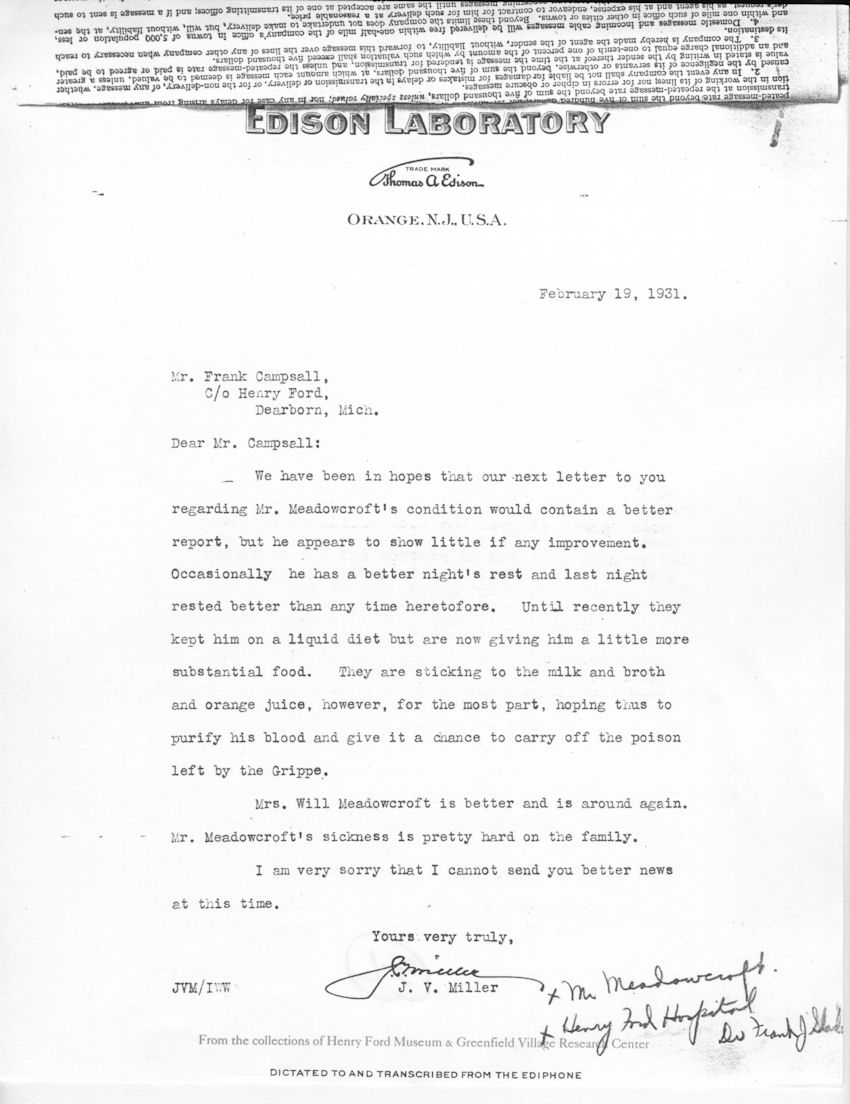 [X001C9AF], Letter from John Vincent Miller to Frank Campsall, February 19th, 1931 1931-02-19
[X001C9AF], Letter from John Vincent Miller to Frank Campsall, February 19th, 1931 1931-02-19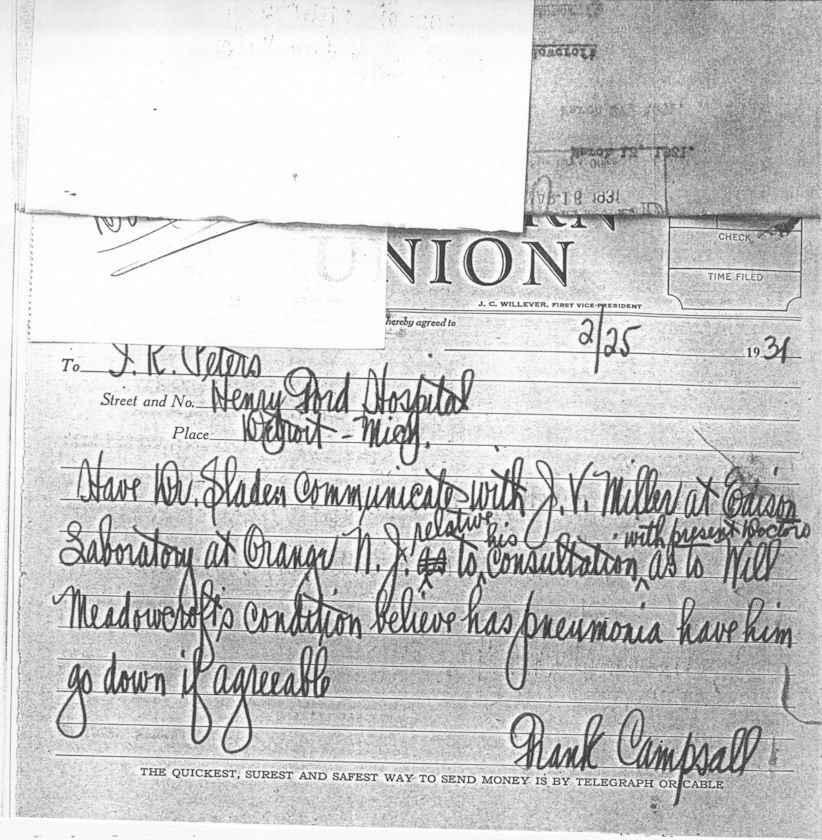 [X001C9AG], Telegram from Frank Campsall to J R Peters, February 25th, 1931 1931-02-25
[X001C9AG], Telegram from Frank Campsall to J R Peters, February 25th, 1931 1931-02-25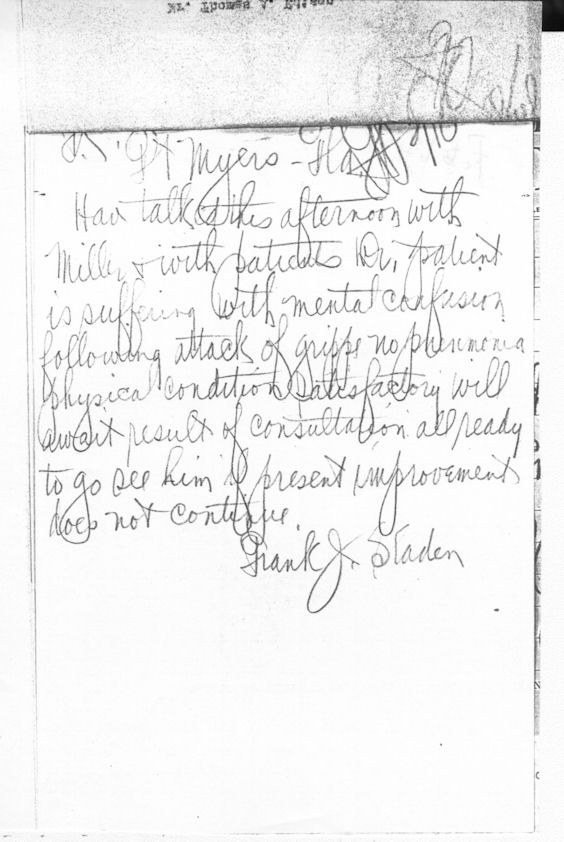 [X001C9AH], Letter from Frank J Sladen to Frank Campsall, February 1931 1931-02-00
[X001C9AH], Letter from Frank J Sladen to Frank Campsall, February 1931 1931-02-00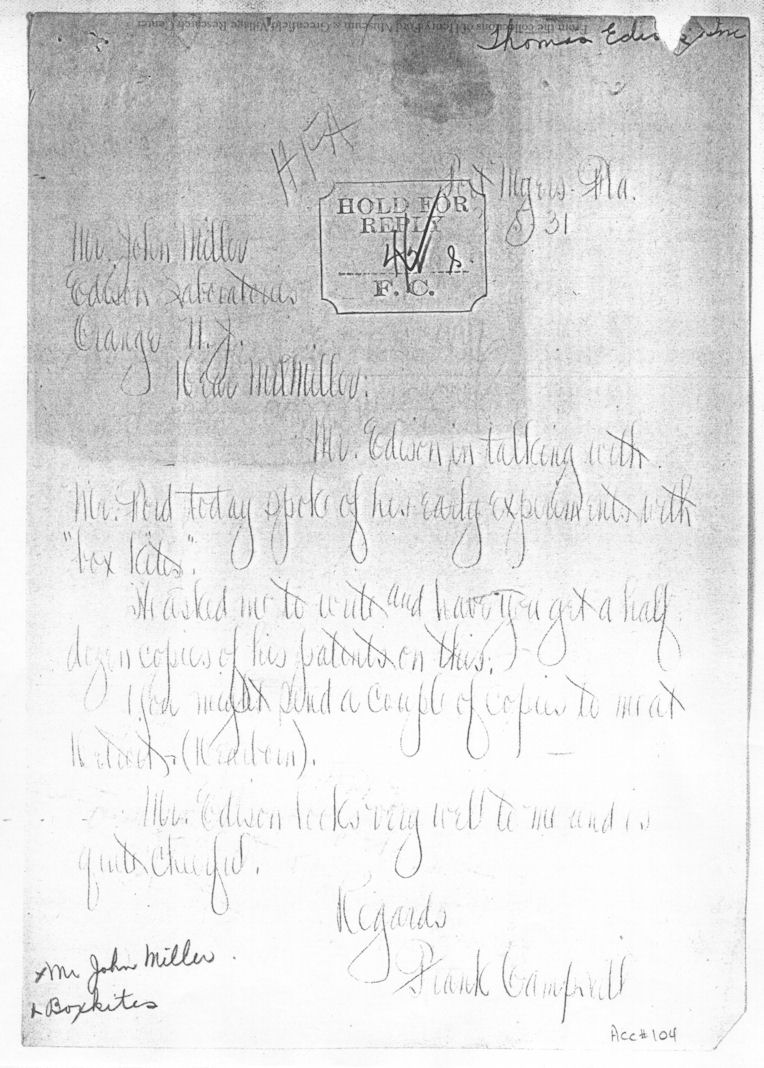 [X001C9AI], Letter from Frank Campsall to John Vincent Miller, March 5th, 1931 1931-03-05
[X001C9AI], Letter from Frank Campsall to John Vincent Miller, March 5th, 1931 1931-03-05 [X001C9AJ], Letter from John Vincent Miller to Thomas Alva Edison, March 13th, 1931 1931-03-13
[X001C9AJ], Letter from John Vincent Miller to Thomas Alva Edison, March 13th, 1931 1931-03-13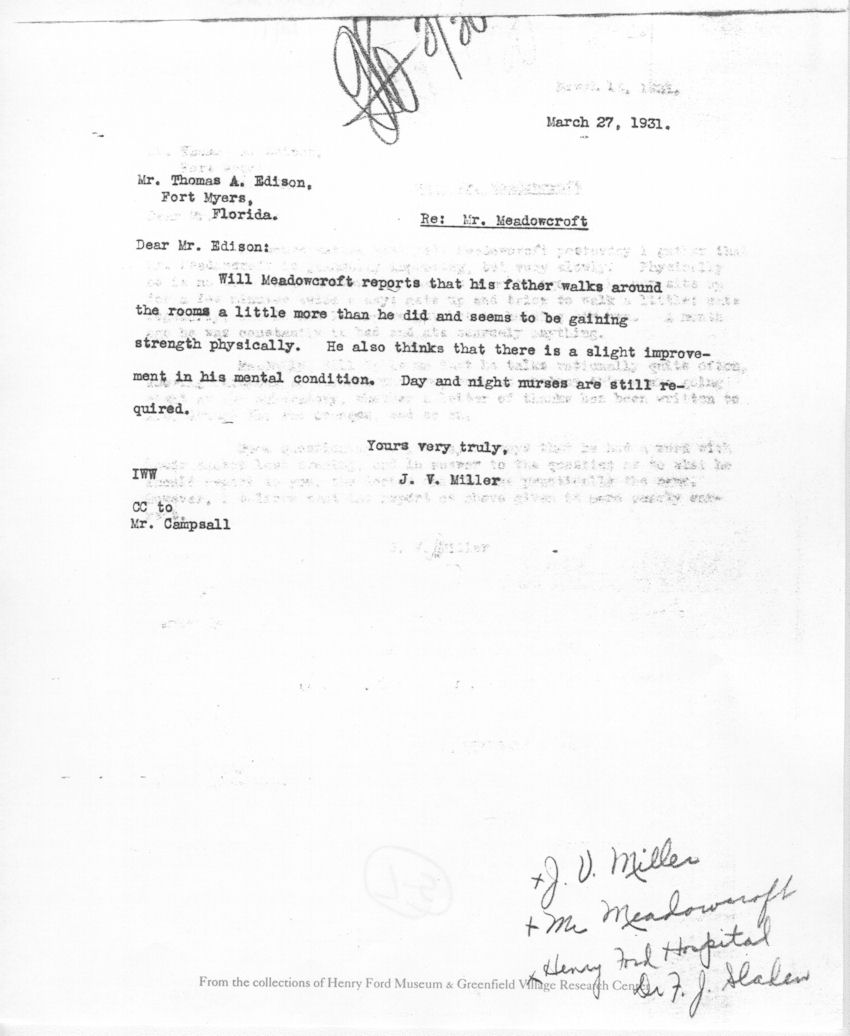 [X001C9AK], Letter from John Vincent Miller to Thomas Alva Edison, March 27th, 1931 1931-03-27
[X001C9AK], Letter from John Vincent Miller to Thomas Alva Edison, March 27th, 1931 1931-03-27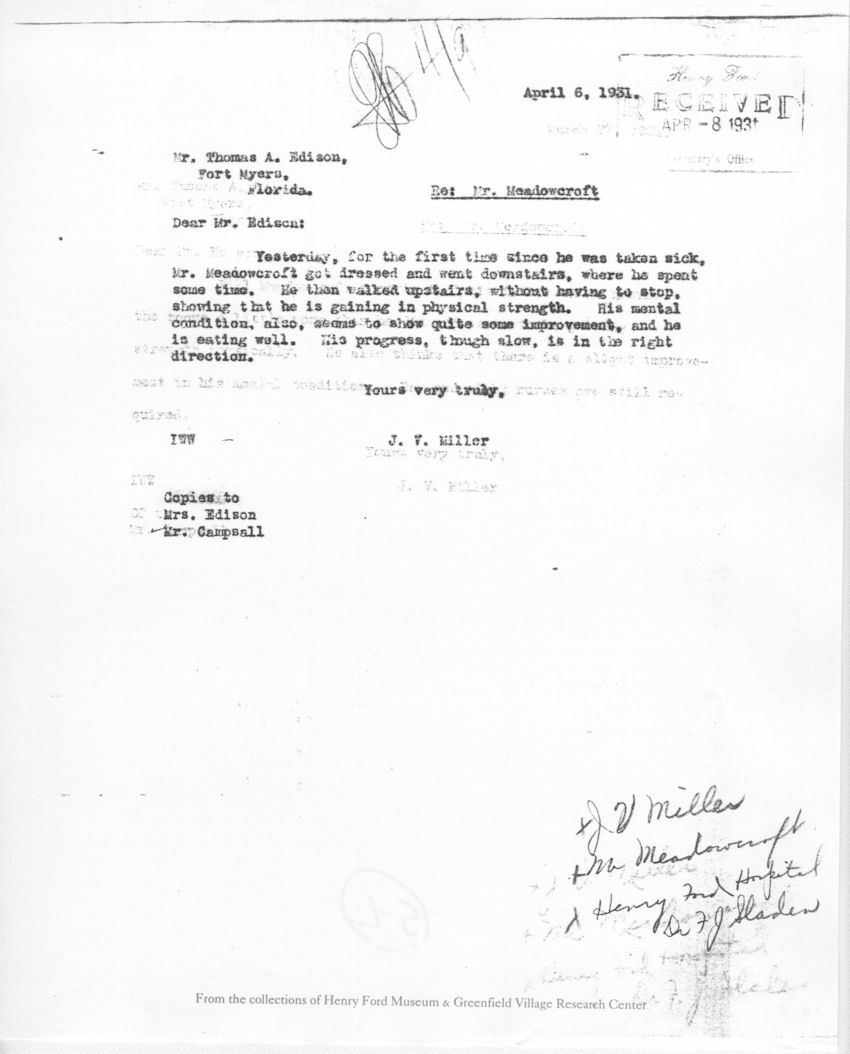 [X001C9AL], Letter from John Vincent Miller to Thomas Alva Edison, April 6th, 1931 1931-04-06
[X001C9AL], Letter from John Vincent Miller to Thomas Alva Edison, April 6th, 1931 1931-04-06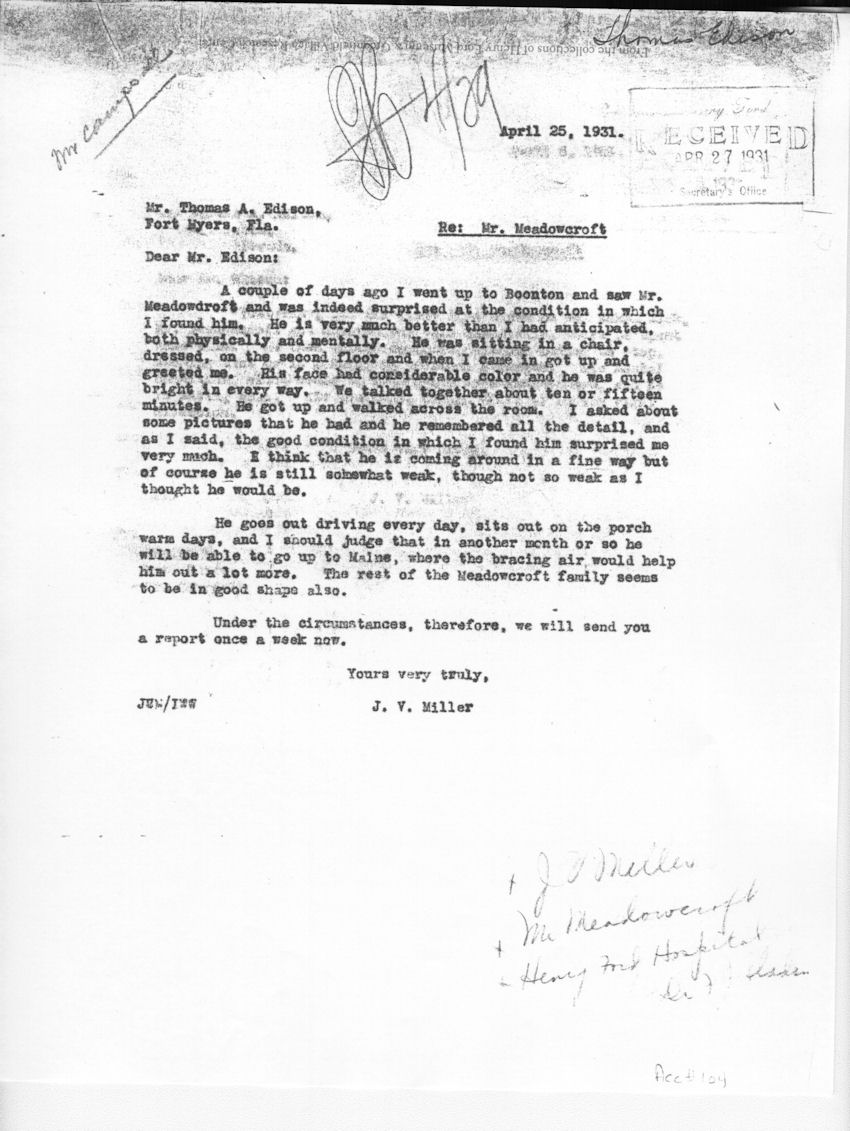 [X001C9AM], Letter from John Vincent Miller to Thomas Alva Edison, April 25th, 1931 1931-04-25
[X001C9AM], Letter from John Vincent Miller to Thomas Alva Edison, April 25th, 1931 1931-04-25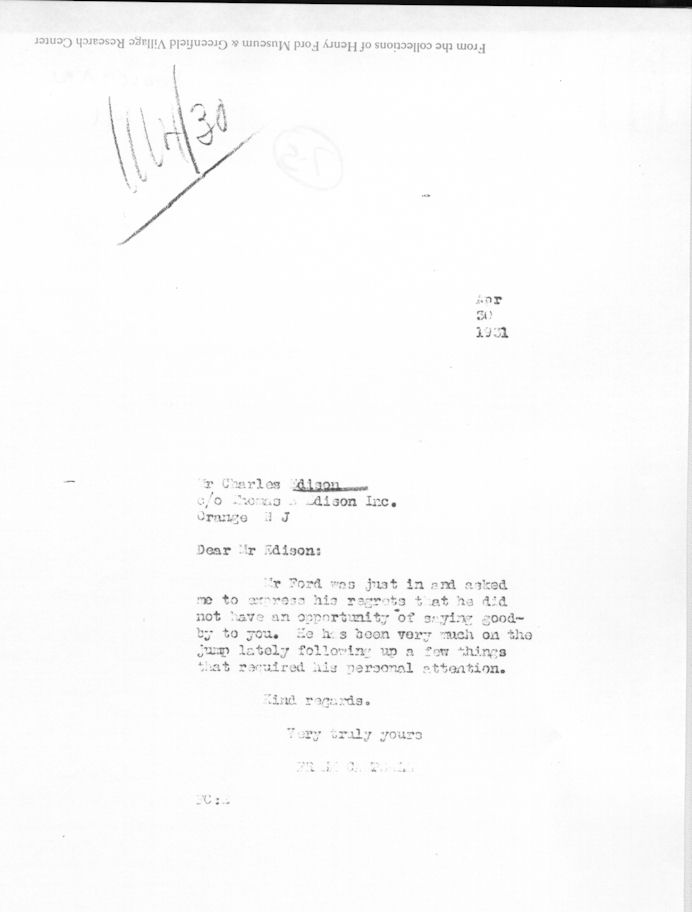 [X001C9AN], Letter from Frank Campsall to Charles Edison, April 30th, 1931 1931-04-30
[X001C9AN], Letter from Frank Campsall to Charles Edison, April 30th, 1931 1931-04-30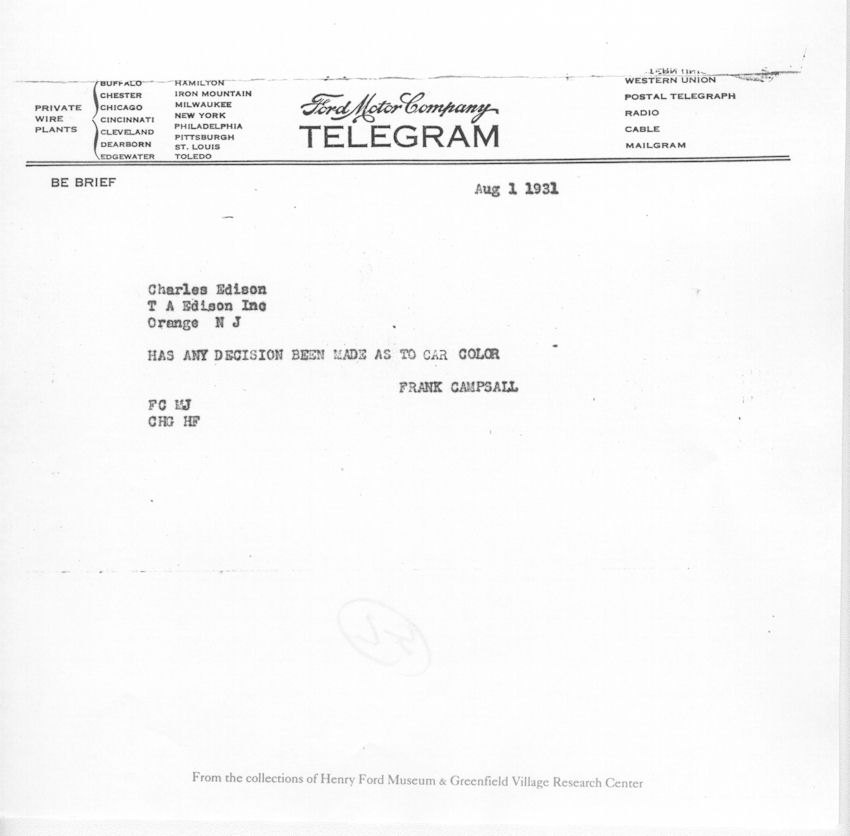 [X001C9AO], Telegram from Frank Campsall to Charles Edison, August 1st, 1931 1931-08-01
[X001C9AO], Telegram from Frank Campsall to Charles Edison, August 1st, 1931 1931-08-01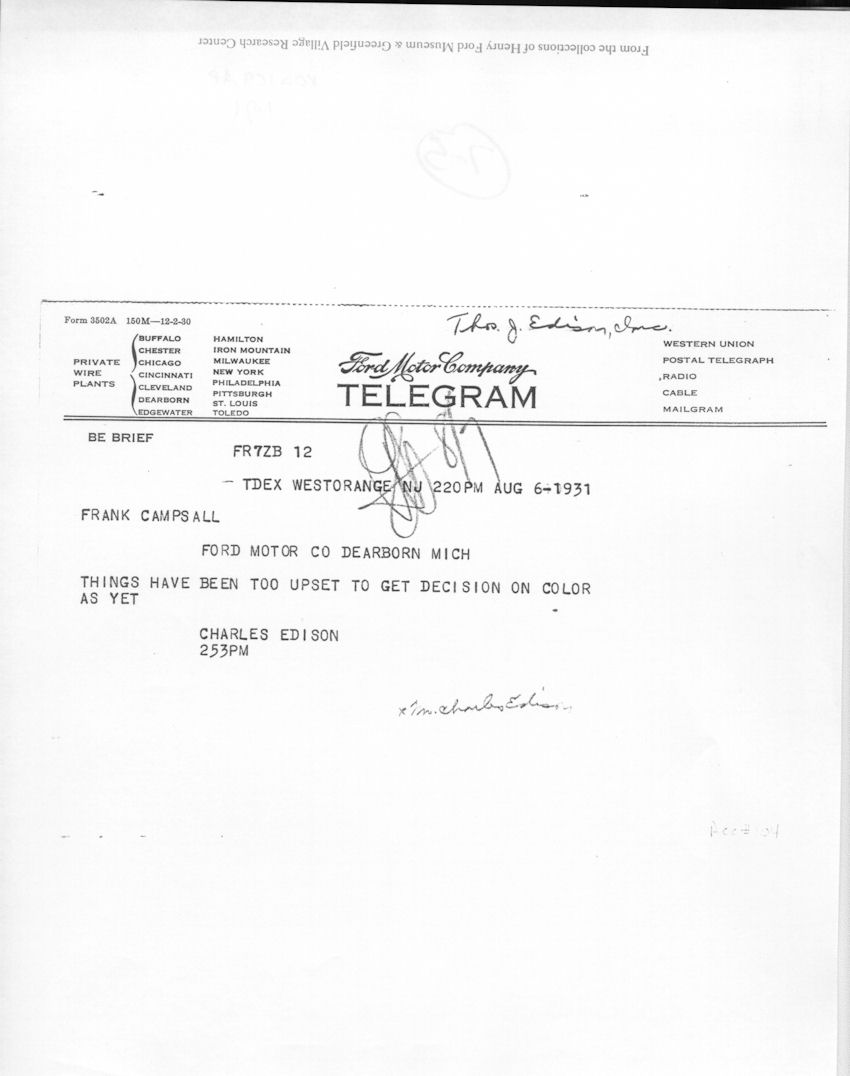 [X001C9AP], Telegram from Charles Edison to Frank Campsall, August 6th, 1931 1931-08-06
[X001C9AP], Telegram from Charles Edison to Frank Campsall, August 6th, 1931 1931-08-06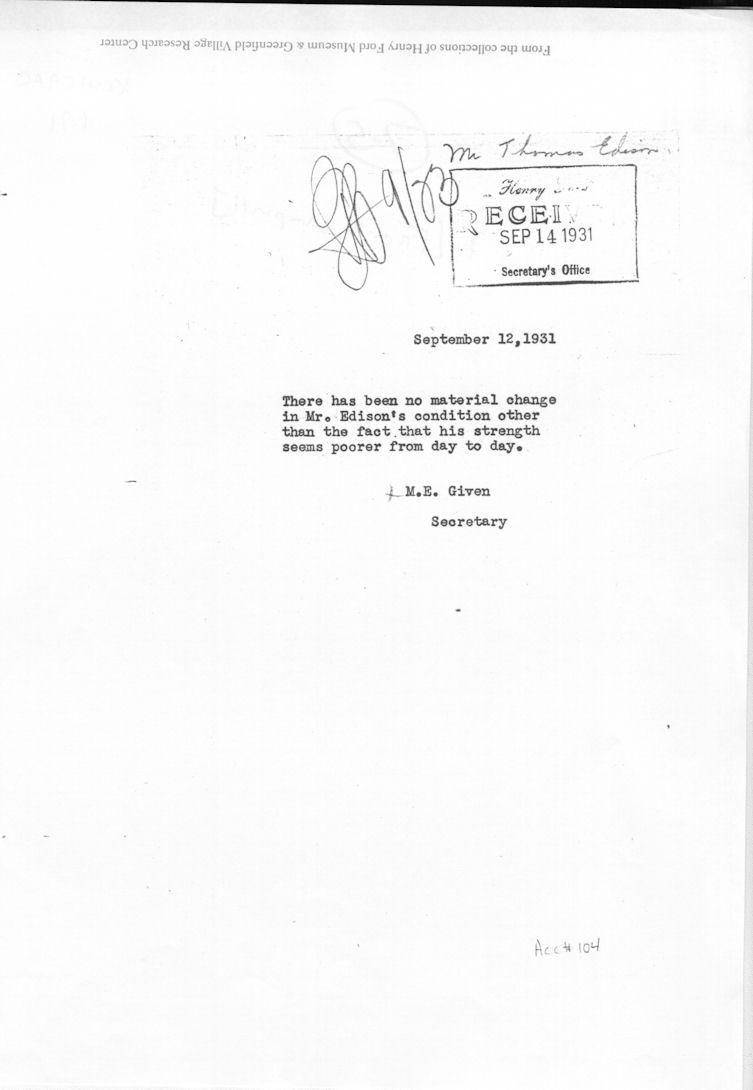 [X001C9AQ], Letter from Mary Elizabeth Given to Frank Campsall, September 12th, 1931 1931-09-12
[X001C9AQ], Letter from Mary Elizabeth Given to Frank Campsall, September 12th, 1931 1931-09-12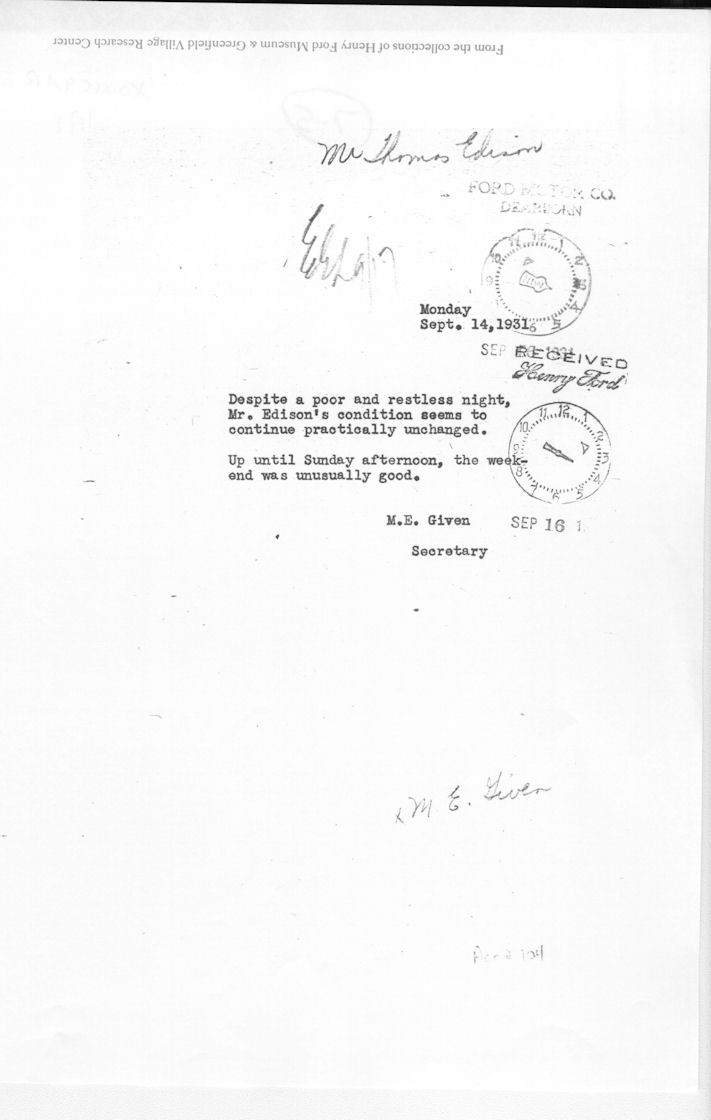 [X001C9AR], Letter from Mary Elizabeth Given to Ernest Gustav Liebold, September 14th, 1931 1931-09-14
[X001C9AR], Letter from Mary Elizabeth Given to Ernest Gustav Liebold, September 14th, 1931 1931-09-14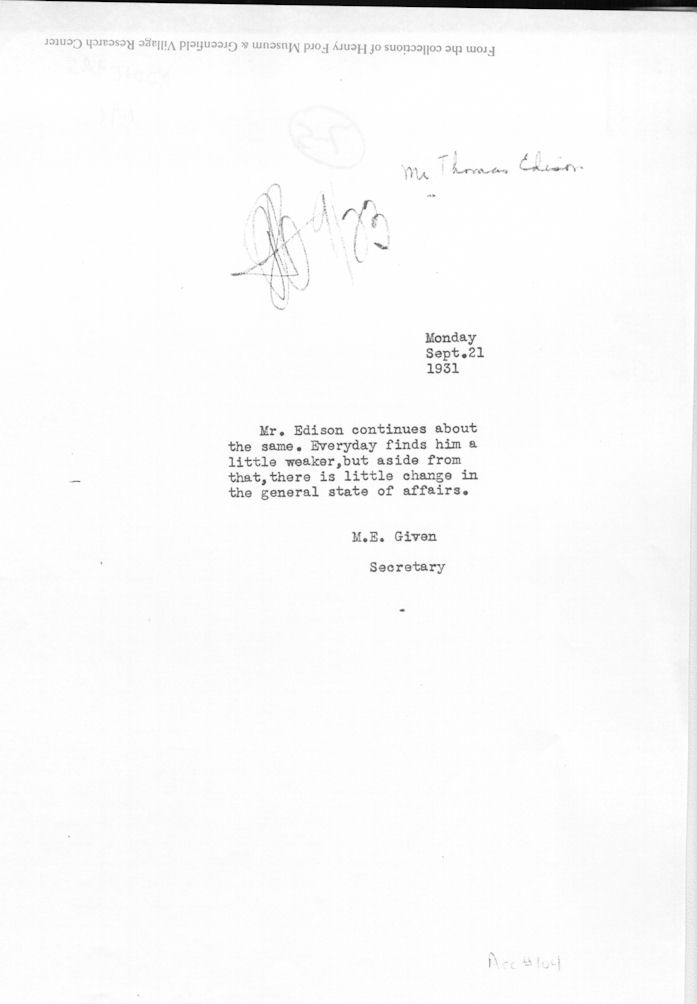 [X001C9AS], Letter from Mary Elizabeth Given to Frank Campsall, September 21st, 1931 1931-09-21
[X001C9AS], Letter from Mary Elizabeth Given to Frank Campsall, September 21st, 1931 1931-09-21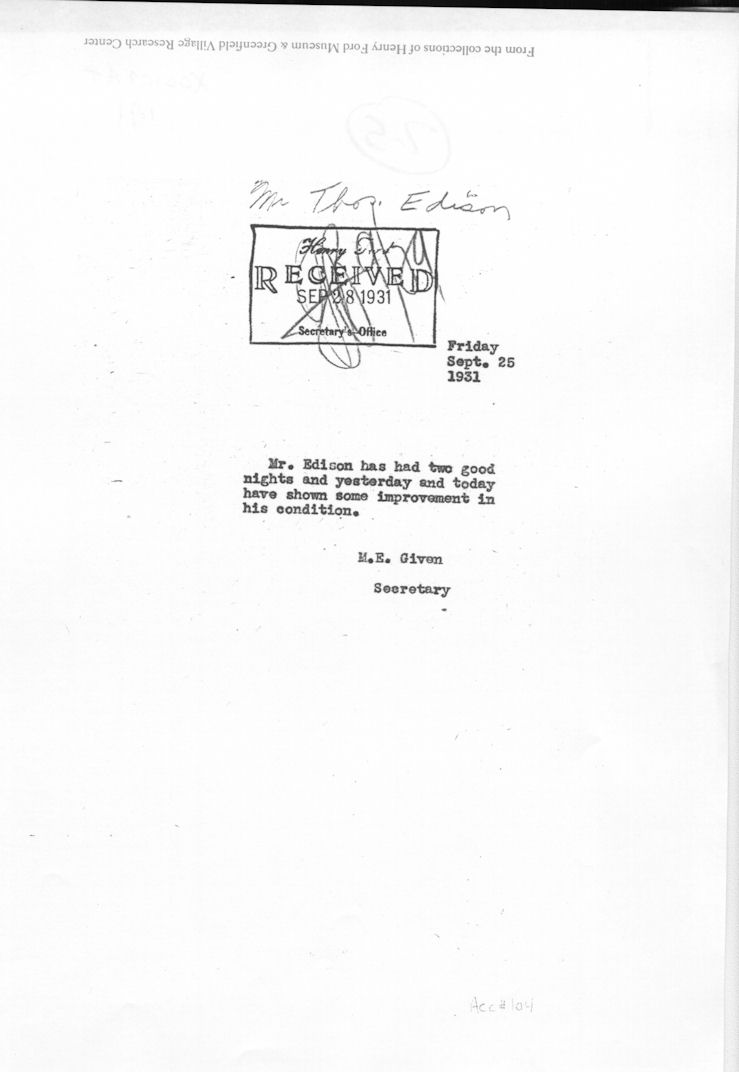 [X001C9AT], Letter from Mary Elizabeth Given to Frank Campsall, September 25th, 1931 1931-09-25
[X001C9AT], Letter from Mary Elizabeth Given to Frank Campsall, September 25th, 1931 1931-09-25 [X001C9AU], Letter from Mary Elizabeth Given to Ernest Gustav Liebold, September 28th, 1931 1931-09-28
[X001C9AU], Letter from Mary Elizabeth Given to Ernest Gustav Liebold, September 28th, 1931 1931-09-28 [X001C9AV], Telegram from Charles Edison to Frank Campsall, December 16th, 1931 1931-12-16
[X001C9AV], Telegram from Charles Edison to Frank Campsall, December 16th, 1931 1931-12-16